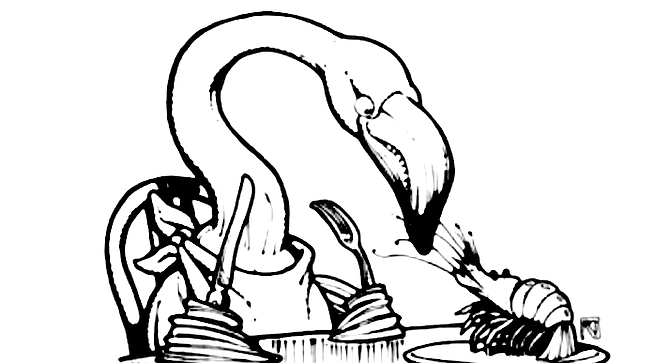 Facebook
Facebook
 X
X
 Instagram
Instagram
 TikTok
TikTok
 Youtube
Youtube

Dear M.A.: I heard from two sources recently that flamingos are pink because they eat shrimp as their main diet. Question: Since shrimp are only pink after they are cooked, how did these sources deduce their reasoning? Who cooks shrimp for flamingos in their natural habitat? Does their metabolism change a chemical in the shrimp to pink as cooking them would? Sounds sketchy to me. — S. Moore, San Diego
Well, of course it’s not the shrimp. It’s the cocktail sauce. Much more logical, no?
No? Humph. When did you people start getting so suspicious?
Okay, okay. It is the shrimp. And the algae. And the other aquatic goodies the birds filter from the water they suck through those remarkable beaks. No need to saut£ the marshy goo to color their feathers, though. Flamingos’ natural diet is packed with carotenoids, nature’s coloring agents (biochromes) that produce hues ranging from the scarlet in corals and tomatoes to the yellow in butter. Certain protein-bound carotenoids create the blue-green shades of shrimp and lobster still on the hoof. When heat is applied to shrimp, the protein coagulates and reveals the carotenoid pigment, which makes those fine edibles appear bright pink. The chemistry is slightly more complicated in the shell of the lobster.
Unlike some biochromes such as melanin, red pigments are not created in an animal’s body. It has to eat a plant containing the pigment or eat something that has eaten the plant. Once the birds have ingested the carotenoids, some of them are changed chemically in their bodies. If they’re fed beta carotene, for instance, they can metabolize that into two other biochromes, but the birds can’t create the beta carotene by themselves.
Baby flamingos’ first meals consist of crop milk regurgitated by the parents. The “milk” is bright red and helps color the fledglings’ feathers. Flamingo fat is also red, since most carotenoids are fat soluble; and certain flamingo internal organs take on a flaming red hue from the dyes as well.
Anyway, if you’re thinking about stocking your back yard with flamingos, you’d better be prepared with the proper grub or you’ll have a pretty pale-looking flock after their first molt.
I checked with the head flamingo wrangler at the San Diego Zoo and got the zoo recipe for nonbreeding birds. Take a bunch of Purina Trout Chow (chow for trout, not chow from trout), add ground carrots, Kruse Flamingo Diet (a cornmeal and soy mixture), and roxanthin, blend it into a gruel, put it in tubs, deposit the tubs in the birds’ feeding pond, and stand back. Roxanthin is the secret ingredient for keeping the birds the proper shade of pink. It’s a strong scarlet dye. The whole process seems faintly reminiscent of the old biology class trick of creating blue carnations by sticking white ones in blue-dyed water.


Dear M.A.: I heard from two sources recently that flamingos are pink because they eat shrimp as their main diet. Question: Since shrimp are only pink after they are cooked, how did these sources deduce their reasoning? Who cooks shrimp for flamingos in their natural habitat? Does their metabolism change a chemical in the shrimp to pink as cooking them would? Sounds sketchy to me. — S. Moore, San Diego
Well, of course it’s not the shrimp. It’s the cocktail sauce. Much more logical, no?
No? Humph. When did you people start getting so suspicious?
Okay, okay. It is the shrimp. And the algae. And the other aquatic goodies the birds filter from the water they suck through those remarkable beaks. No need to saut£ the marshy goo to color their feathers, though. Flamingos’ natural diet is packed with carotenoids, nature’s coloring agents (biochromes) that produce hues ranging from the scarlet in corals and tomatoes to the yellow in butter. Certain protein-bound carotenoids create the blue-green shades of shrimp and lobster still on the hoof. When heat is applied to shrimp, the protein coagulates and reveals the carotenoid pigment, which makes those fine edibles appear bright pink. The chemistry is slightly more complicated in the shell of the lobster.
Unlike some biochromes such as melanin, red pigments are not created in an animal’s body. It has to eat a plant containing the pigment or eat something that has eaten the plant. Once the birds have ingested the carotenoids, some of them are changed chemically in their bodies. If they’re fed beta carotene, for instance, they can metabolize that into two other biochromes, but the birds can’t create the beta carotene by themselves.
Baby flamingos’ first meals consist of crop milk regurgitated by the parents. The “milk” is bright red and helps color the fledglings’ feathers. Flamingo fat is also red, since most carotenoids are fat soluble; and certain flamingo internal organs take on a flaming red hue from the dyes as well.
Anyway, if you’re thinking about stocking your back yard with flamingos, you’d better be prepared with the proper grub or you’ll have a pretty pale-looking flock after their first molt.
I checked with the head flamingo wrangler at the San Diego Zoo and got the zoo recipe for nonbreeding birds. Take a bunch of Purina Trout Chow (chow for trout, not chow from trout), add ground carrots, Kruse Flamingo Diet (a cornmeal and soy mixture), and roxanthin, blend it into a gruel, put it in tubs, deposit the tubs in the birds’ feeding pond, and stand back. Roxanthin is the secret ingredient for keeping the birds the proper shade of pink. It’s a strong scarlet dye. The whole process seems faintly reminiscent of the old biology class trick of creating blue carnations by sticking white ones in blue-dyed water.
Comments